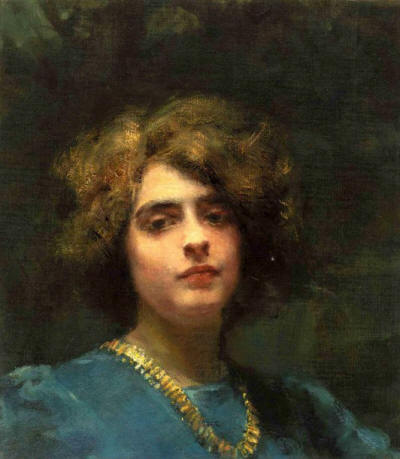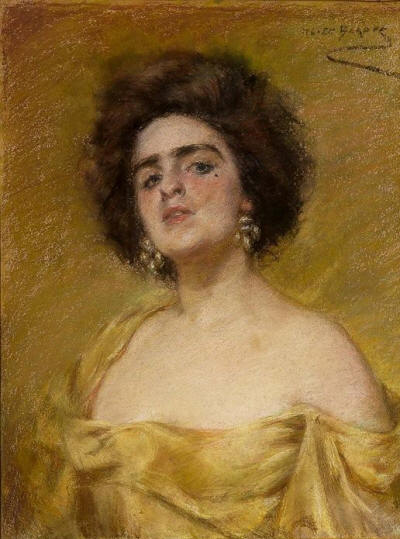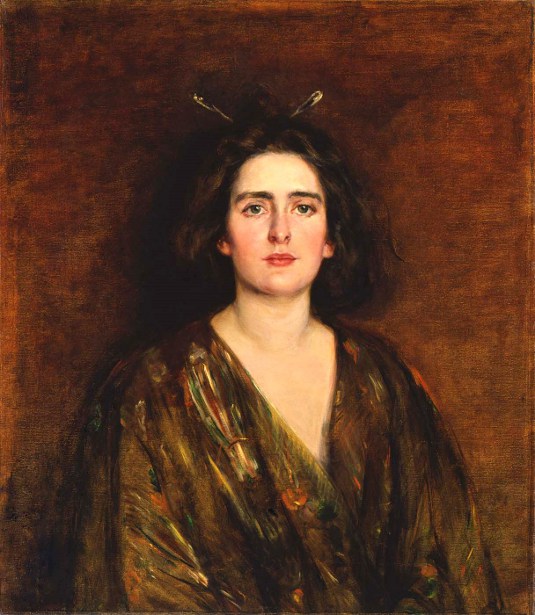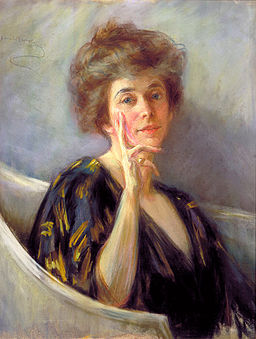Queer Places:
Passy Cemetery, 2 Rue du Commandant Schloesing, 75016 Paris, Francia
 Laura
Dreyfus-Barney (born Laura Clifford Barney; 30 November
1879, Cincinnati, Ohio – 18 August 1974, Paris, France) was a leading
American Baháʼí teacher and philanthropist. In 1974, during an interview,
Alice Roosevelt
Longworth was reminded of a story of a friend of hers in the old days (the
turn of the century) who, after being forbidden by her father to see a young
man, dressed in men's clothes and cut her hair. The father remarked, "What an
odd revenge." Longworth laughed heartily, "Homosexuality and lesbianism were
very fashionable in those days," she said. "And it was quite acceptable. At
least as far as I was concerned." It seems Margaret Cassini, Igor's mother and
the daughter of a South American ambassador, had been a great friend of Alice
Longworth's and they had taken a walk one day in the White House garden. Miss
Cassini proceeded to tell young Alice that a mutual friend was saying horrid
things about her. Alice asked what, and the friend replied that a certain Miss
Alice Barney (later Laura
Clifford Barney) was claiming to be in love with Alice. "I don't think
that's nasty, why I think that's lovely, so nice. I'm so glad to hear she is,"
Mrs. Longworth recalled saying with a mischievous smile. Margaret Cassini
apparently snorted with contempt, which pleased Alice enormously. "Still," she
said, "usually I thought it better to keep away from joking about the lesbian
thing since my father was President."
Laura
Dreyfus-Barney (born Laura Clifford Barney; 30 November
1879, Cincinnati, Ohio – 18 August 1974, Paris, France) was a leading
American Baháʼí teacher and philanthropist. In 1974, during an interview,
Alice Roosevelt
Longworth was reminded of a story of a friend of hers in the old days (the
turn of the century) who, after being forbidden by her father to see a young
man, dressed in men's clothes and cut her hair. The father remarked, "What an
odd revenge." Longworth laughed heartily, "Homosexuality and lesbianism were
very fashionable in those days," she said. "And it was quite acceptable. At
least as far as I was concerned." It seems Margaret Cassini, Igor's mother and
the daughter of a South American ambassador, had been a great friend of Alice
Longworth's and they had taken a walk one day in the White House garden. Miss
Cassini proceeded to tell young Alice that a mutual friend was saying horrid
things about her. Alice asked what, and the friend replied that a certain Miss
Alice Barney (later Laura
Clifford Barney) was claiming to be in love with Alice. "I don't think
that's nasty, why I think that's lovely, so nice. I'm so glad to hear she is,"
Mrs. Longworth recalled saying with a mischievous smile. Margaret Cassini
apparently snorted with contempt, which pleased Alice enormously. "Still," she
said, "usually I thought it better to keep away from joking about the lesbian
thing since my father was President."
Laura Clifford Barney was the daughter of Albert and Alice Pike Barney.
Albert Clifford Barney was the son of a manufacturer of railway cars and was
of English descent. Alice was of French, Dutch and German-Jewish ancestry, and
was a socially prominent artist from Washington, D.C. Laura and her elder
sister Natalie Clifford Barney were
educated by private tutors. Laura became a leading American Baháʼí teacher and
philanthropist. She is best known for having compiled the Baháʼí text Some
Answered Questions from her interviews with ʻAbdu'l-Bahá during her visit to
ʿAkkāʾ, Palestine, between 1904 and 1906.[1]





She attended Les Ruches, a French boarding school founded by feminist Marie
Souvestre. While continuing her studies in Paris, Laura met May
Bolles (later Maxwell), a Canadian Baháʼí, and was converted to the faith in
about 1900. Her mother converted soon afterward. In 1911, she
married Hippolyte Dreyfus (married name Hippolyte Dreyfus-Barney).[2]
Laura Barney financed the visit of the Persian Baháʼí scholar Mírzá
Abu'l-Faḍl-i-Gulpáygání to the United States in 1901-04, in order to propagate
the faith there, and helped to publish the translation of his Ḥojaj al-bahīya
(Cairo, 1342/1925; tr. Ali-Kuli Khan as The Baháʼí Proofs, New York, 1902; 2nd
ed., ed. J. R. I. Cole, Wilmette, Ill., 1983). In 1904 she visited
ʻAbdu'l-Bahá in ʿAkkāʾ, Palestine, where she remained about two years,
acquiring a working knowledge of Persian and becoming an intimate of his
household. During that time she arranged to have ʻAbdu'l-Bahá's answers to her
questions, mainly on philosophy and Christian theology, recorded by his
secretaries. She collaborated with her future husband, Hippolyte Dreyfus, on
the editing and translation of this work (al-Nūr al-abhā fīmofāważāt
ʻAbdu'l-Bahá, Leiden, 1908; tr. L. C. Barney and H. Dreyfus as Some Answered
Questions, London, 1908;[3] tr.
H. Dreyfus as Les leçons de Saint Jean d'Acre, Paris, 1909). In 1905-06 she
visited Persia, the Caucasus, and Russia with Dreyfus. After their marriage in
April 1911, when they both adopted the surname Dreyfus-Barney, she traveled
extensively with him. Both Laura and Hippolyte Dreyfus-Barney played a vital
role in ʻAbdu'l-Bahá's successful visits to the West. Their intimate and
personal relationship with him is unquestioned. Even though Hippolyte
accompanied ʻAbdu'l-Bahá more so than Laura and translated many of his
speeches to French. Nonetheless, Laura's role is unique in her special bond
she developed through her travels to Akka during her youth and later as his
host in Paris. Her proficiency in Persian language is another aspect that was
unique at the time for a woman. ʻAbdu'l-Bahá's first visit to Paris in
September 1911 was hosted by Laura and her husband. They also traveled to
London and acted as his interpreters. They were his "confidantes."
ʻAbdu'l-Bahá's next visit to the west and the US took place in 1912. Laura was
present again in New York. New Jersey and Washington, DC. Upon his return to
London, both Laura and Hippolyte were present. Their last visit to Akka to
visit ʻAbdu'l-Bahá was in 1921, the same year that he died.[4]
Dreyfus-Barney was active in the International Council of Women from the 1920s
to the 1960s and was its representative to the League of Nations and then
later worked connecting the United Nation's Children's Fund with various NGOs
after World War II.[5] Between
these, during World War I, Dreyfus-Barney served in the American Ambulance
Corps (1914-15), and the American Red Cross (1916-18) in France, and helped to
establish the first children's hospital in Avignon (1918). For her lifetime of
services she was named chevalier (1925) and officer (1937) of the French
Légion d'Honneur. There is a copy of her unpublished memoirs in the Baháʼí
national archives in France.
My published books:


BACK TO HOME PAGE

 Laura
Dreyfus-Barney (born Laura Clifford Barney; 30 November
1879, Cincinnati, Ohio – 18 August 1974, Paris, France) was a leading
American Baháʼí teacher and philanthropist. In 1974, during an interview,
Alice Roosevelt
Longworth was reminded of a story of a friend of hers in the old days (the
turn of the century) who, after being forbidden by her father to see a young
man, dressed in men's clothes and cut her hair. The father remarked, "What an
odd revenge." Longworth laughed heartily, "Homosexuality and lesbianism were
very fashionable in those days," she said. "And it was quite acceptable. At
least as far as I was concerned." It seems Margaret Cassini, Igor's mother and
the daughter of a South American ambassador, had been a great friend of Alice
Longworth's and they had taken a walk one day in the White House garden. Miss
Cassini proceeded to tell young Alice that a mutual friend was saying horrid
things about her. Alice asked what, and the friend replied that a certain Miss
Alice Barney (later Laura
Clifford Barney) was claiming to be in love with Alice. "I don't think
that's nasty, why I think that's lovely, so nice. I'm so glad to hear she is,"
Mrs. Longworth recalled saying with a mischievous smile. Margaret Cassini
apparently snorted with contempt, which pleased Alice enormously. "Still," she
said, "usually I thought it better to keep away from joking about the lesbian
thing since my father was President."
Laura
Dreyfus-Barney (born Laura Clifford Barney; 30 November
1879, Cincinnati, Ohio – 18 August 1974, Paris, France) was a leading
American Baháʼí teacher and philanthropist. In 1974, during an interview,
Alice Roosevelt
Longworth was reminded of a story of a friend of hers in the old days (the
turn of the century) who, after being forbidden by her father to see a young
man, dressed in men's clothes and cut her hair. The father remarked, "What an
odd revenge." Longworth laughed heartily, "Homosexuality and lesbianism were
very fashionable in those days," she said. "And it was quite acceptable. At
least as far as I was concerned." It seems Margaret Cassini, Igor's mother and
the daughter of a South American ambassador, had been a great friend of Alice
Longworth's and they had taken a walk one day in the White House garden. Miss
Cassini proceeded to tell young Alice that a mutual friend was saying horrid
things about her. Alice asked what, and the friend replied that a certain Miss
Alice Barney (later Laura
Clifford Barney) was claiming to be in love with Alice. "I don't think
that's nasty, why I think that's lovely, so nice. I'm so glad to hear she is,"
Mrs. Longworth recalled saying with a mischievous smile. Margaret Cassini
apparently snorted with contempt, which pleased Alice enormously. "Still," she
said, "usually I thought it better to keep away from joking about the lesbian
thing since my father was President."





